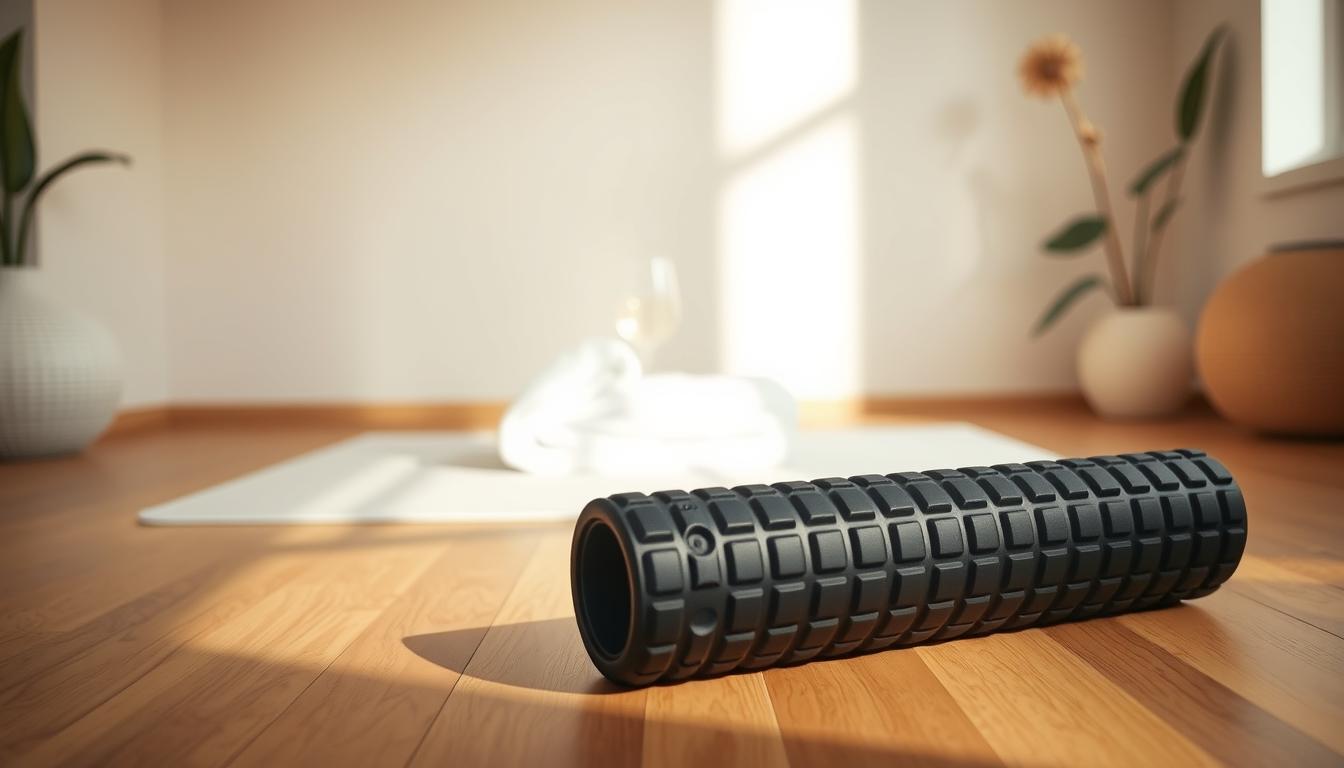Daily micro-stretches help reduce neck pain, becoming a must-have in your day. With most of us sitting for long hours, neck discomfort is common. It can really affect our daily life. This guide will tell you how tiny stretches can make a big difference in neck flexibility and relief. By using these easy methods, you can fight the bad impacts of sitting too much. This supports your neck’s health.
Understanding Neck Pain and Its Causes
Many people feel neck pain, often due to different reasons. Poor posture is a big cause, especially for those who sit a lot. Also, how you sleep can make neck pain worse if it strains your neck muscles. Not moving enough can also make your neck tense and sore.
Doing the same thing over and over, like staring at your phone or bending over a computer, can worsen neck pain. Aging plays a role too, as joints get stiffer. Knowing why neck pain happens can help us find ways to ease the pain and keep our necks healthier.
Importance of Daily Micro-Stretches for Neck Pain Relief
Doing micro-stretches every day can greatly ease neck pain. These short, focused stretches reduce muscle tension and improve blood flow. They also make you feel more relaxed. By stretching gently, you’re taking steps to prevent neck pain before it starts.
It’s important to do these micro-stretches often. Try to hold each stretch for about 20 seconds. Adding them to your daily habits can make you more flexible. This slow and steady practice helps your muscles move better and lessens pain gradually.
Daily Micro-Stretches for Neck Pain Prevention
Adding daily micro-stretches to your routine is a great way to avoid neck pain. These tiny movements focus on important areas. They help your neck, shoulders, and upper back become more flexible and strong. Here are some stretches you can do to lessen tension and improve your movement:
- Shoulder Rolls: Gently roll your shoulders forward and backward to release tension.
- Head Glides: Keep your spine straight while sliding your head forward and backward to improve alignment.
- Gentle Neck Rotations: Rotate your head slowly from side to side to maintain a healthy range of motion.
These stretching exercises help make your muscles more flexible. That’s really important to avoid discomfort from sitting too long or repeating the same motions. By doing a mix of micro-stretches, you keep your routine diverse and effective in preventing neck pain. Doing these stretches often makes your neck muscles healthier, lowering your chances of pain and strain.
Best Practices for Doing Micro-Stretches
For effective micro-stretching, following a few best practices is crucial. It’s important to keep the right body posture. This ensures you get good results and reduce the risk of strain. Make sure your neck and spine are aligned when you stretch.
It’s vital to breathe normally while stretching. Regular breathing helps your muscles stay loose and responsive, improving the stretch. Try to relax your muscles with each stretch for a better experience.
Don’t bounce or force your body into hard positions, as this might cause harm. Use gentle and controlled moves instead. Aim to keep each stretch for 10 to 20 seconds but stop if you feel pain. Making micro-stretching a daily habit brings the most benefits over time.
- Maintain normal breathing.
- Relax your muscles during stretches.
- Hold stretches for 10 to 20 seconds.
- Avoid bouncing or forcing movements.
- Incorporate stretches regularly for maximum benefits.
Simple Micro-Stretches You Can Do at Your Desk
In today’s fast-paced work world, it’s key to fight neck pain effectively. Simple Desk Stretches are great for Workplace Neck Pain Relief. They’re especially helpful when you’re sitting for long. Doing Quick Office Micro-Stretches can make your muscles feel better and boost your work.
Adding these stretches to your day is simple. Here are a couple of easy micro-stretches for your desk:
- Neck Rotations: Slowly turn your head from one side to the other. Keep each side for a few seconds to ease tension.
- Shoulder Shrugs: Lift your shoulders up, hold them like that briefly, then lower them. Do this a few times.
- Wrist Flexor Stretches: Stick one arm out, palm facing up, and pull gently on your fingers with the other hand. This stretches your wrist and forearm.
Try to do these stretches during short breaks all day. 5-10 minutes for every hour you’re at your desk is ideal. It’s also smart to stand and walk around sometimes. This helps lower muscle tightness and makes your posture better.
The Role of Ergonomics in Preventing Neck Pain
An Ergonomic Workspace is key to preventing neck pain. By making simple adjustments to your workstation, you can better your posture and lessen neck strain. It’s crucial to get the height of your chair, monitor, and keyboard right to keep your neck in a comfy position.
To set up a workspace that’s good for your neck, try these tips:
- Adjust your chair height so your feet are flat on the ground, with your knees and hips at the same level.
- Keep the monitor at eye level about an arm’s length away. This helps avoid too much head turning or tilting.
- Set your keyboard at a height that lets your elbows stay by your side. This helps keep your shoulders relaxed.
Choosing the right furniture and tools is also crucial in Office Ergonomics. For instance, chairs with lumbar support help keep your spine’s natural shape while sitting. Such an arrangement supports healthy body movements and makes working at a desk more comfortable for longer periods.
Incorporating Stretching into Your Daily Routine
Adding stretching to your daily life boosts your overall health. Set up reminders to stretch throughout the day. This could be after finishing tasks or during breaks.
A structured stretching plan helps form lasting habits. You can do short stretches while watching TV or commuting. These small steps can improve your neck and overall flexibility.
Knowing your limits is very important. Slowly increase how long and hard you stretch to avoid injury. Staying in a stretch for at least two minutes can offer better outcomes. It helps build a more effective routine.
Stretching Techniques for Effective Pain Relief
Adding Pain Relief Stretching to your daily activities can help ease your pain. Neck Pain Techniques like neck flexion and extension help loosen the cervical spine. Gentle head turns also aid in keeping your neck flexible and reducing tightness.
The ‘neck relaxer’ method is really useful. You sit up straight and gently lean your head towards your shoulders, pausing for a bit. The upper trapezius stretch is another good move. You pull one arm down and tilt your head the other way. This helps your muscles relax and lessens tightness.

When doing these stretches, move smoothly and breathe deeply. Stay in each stretch for around five breaths to feel better. Make Therapeutic Stretching a regular habit for the best neck health.
What to Avoid When Stretching Your Neck
Knowing what not to do when stretching your neck is key to avoiding pain. Many people make mistakes that can hurt them or make things worse. Here’s what you should avoid:
- Forcing stretches beyond a comfortable limit: Don’t push your neck too far. It can cause strain and up the risk of stretching too much. Try to stretch gently until it feels good, not painful.
- Neglecting proper form: Stretching the wrong way can make neck problems worse. Make sure your body is properly aligned to get all the good from stretching without risks.
- Skipping a warm-up: Jumping right into stretching without getting your muscles ready can lead to injury. A quick warm-up gets your body set for stretching deeper.
Listen to your body when you stretch. If it hurts or feels really bad, you need to stop right away. Knowing when to stop helps a lot in avoiding more harm.
Benefits of Consistent Stretching for Neck Mobility
Making stretching a daily habit offers big benefits for your neck’s mobility. Adding small stretches throughout your day can lead to better flexibility. This helps get rid of muscle tightness, which often causes discomfort or pain.
One key benefit of regular stretching is better posture. Improved alignment reduces the chance of getting hurt. This supports a healthy neck for your daily activities. Also, as you get more flexible, you feel less tense. This leads to better overall functioning. Stretching is good for both your body and your mind. It can help you feel less stressed, adding to your overall comfort.
To sum up, keeping up with regular stretching has many advantages. By sticking to it, you can improve your neck’s mobility and your physical health in general.
When to Consult a Professional for Neck Pain
Knowing when to get help for neck pain is key for better recovery and health. If trying to treat it yourself doesn’t help, seeking a professional is wise. Experiencing severe pain during certain movements is a clear sign to see a doctor soon.
Pain or numbness that spreads to your arms is a serious concern. This could mean your nerves are affected and need checking. Meeting with a healthcare expert offers treatments like Physical Therapy for Neck Pain suited just for you.
Getting a full check-up matters a lot if your condition doesn’t improve with exercise. Professional advice can uncover the real cause of your pain. This ensures you get the right treatment for a better future.
Conclusion
Let’s wrap things up: using tiny stretches every day can really help ease neck pain. This summary wants you to remember that doing a little bit every day can make a big difference. You can improve how your neck moves and feels with these steps.
Looking back, we went over different ways to get relief from neck pain. Also, it’s good to remember to sit and stand the right way. Doing stretches often is key to a happy, healthy neck, so try to make it a regular habit.
In the end, small stretches don’t just help with neck pain. They also make your overall health better. Start using these easy techniques regularly. Your neck will thank you, and you’ll be able to enjoy life more, pain-free in the long run.



